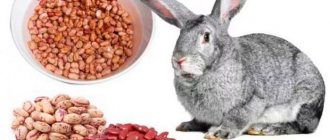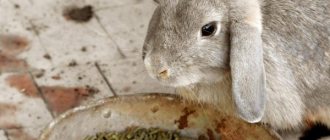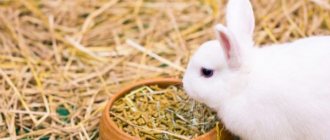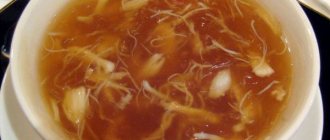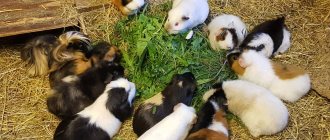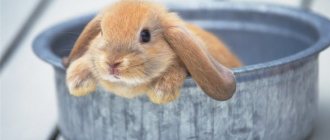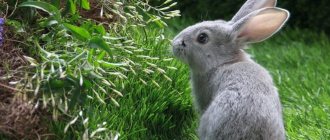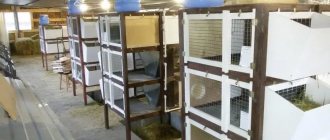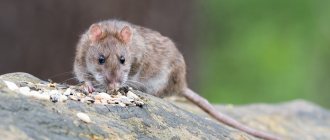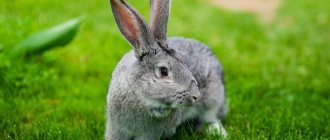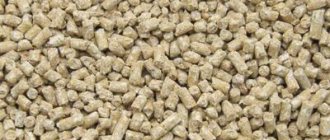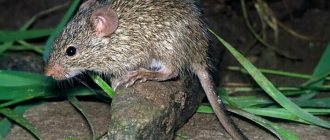200?'200px':”++'px'); - young animals from approximately 0 to 120 days eat 8.6 kg of hay, 8 kg of grain mixture per rabbit
it is necessary to separate the consumption of food by the female when the rabbits were sitting in the nest, and by the female when the rabbits just began to emerge after 20 days. After all, the main amount of food is consumed by the lactating female until the young are 30-40 days old.
Then it is very difficult to separate the feed consumption of the rabbit and the young. And only after 2-2.5 months do the rabbits completely eat food from the feeders. An important point - when were you placed away?
I once calculated the entire year’s feed consumption on the farm and divided it by the number of 3-month-old rabbits received per year.
I have mixed feed with grass meal.
This resulted in 18 kg of feed for each 3-month-old rabbit sold. This included feeding males, females on vacation or who have become unmarried, replacement young animals, etc. This makes the economy more fair. I can roughly say - because... the feed contains 30% grass meal - which can be broken down - 12 kg of grain mixture, 6 kg of hay.
But if you feed hay in feeders, you need to increase the amount of scattering. According to old Soviet standards, 10 kg of hay was harvested per rabbit. When using hay in CC, it is much more economical.
How much grain does a rabbit eat?
Adult rabbits eat
600 g of grass per day, and baby rabbits eat more than 150 g. Nursing rabbits can eat 2 times more than normal. ... Feeding in summer
| Rabbits | Greens and succulent feed (g/day) | Concentrates (g/day) |
Fattening rabbits | 700 | 70 |
| Males in mating | 800 | 40 |
| Pregnant rabbits | 800-900 | 50-70 |
| Nursing rabbits | 1200 | 70 |
What is compound feed, its advantages and disadvantages
Compound feed or combined feed is an essential component of the diet of farm animals. Including rabbits.
It is a mixture of grains and protein, enriched with vitamins and microelements. All its ingredients are well mixed and brought to homogeneity.
It is needed to maintain the balance of nutrients in the body and must be formulated with maximum benefit for a particular animal.
Combined food for rabbits consists of:
- grains - wheat, corn, oats, barley;
- sunflower or soybean cake,
- bran;
- meat and bone and fish meal;
- yeast;
- salt.
Advantages of using compound feed:
- Significantly reduces the time and effort needed to feed animals.
- It is easy to calculate the daily amount of feed for any age.
- Its balance prevents health problems.
- Vitamins and mineral supplements are good prevention of various diseases.
- Guarantees timely weight gain during fattening.
- Allows you to save on the procurement of hay and vegetables, which are also included in the diet of rabbits.
- Easy to store and transport in the household.
Disadvantages of compound feed:
- High prices, which can be reduced by preparing them yourself.
- Quality on which manufacturers save.
The advantages of combined feeds significantly outweigh their disadvantages. The latter can be eliminated by choosing the right supplier and monitoring quality. You can also make compound feed yourself by mixing the ingredients in the required proportions.
There are several factors to determine the amount of feed required.
Feed storage
To obtain greater benefits and material benefits, you need to think about the proper storage of feed and prevent its spoilage.
The main problems of improper storage:
- Infestation by harmful insects and mold. The bran and grains included in the composition are a favorable environment for them.
- Loss of nutritional properties of vitamins and minerals.
- Poisoning or infection of animals in the presence of harmful bacteria.
To prevent such phenomena, special conditions for storing feed are created in livestock farms. Some of them can be used in small farmsteads:
- the presence of a dry, ventilated room;
- avoiding dampness and direct sunlight;
- fight insects and rodents;
- read and follow manufacturers' recommendations;
- observe the expiration dates of the feed.
Tips and tricks
Some rabbit breeders claim that rabbits should have plenty of food for up to six months. However, the nutrition of ornamental breeds will be somewhat different from animals in natural conditions. Pets are virtually stress-free and activity-free. This means that their metabolic processes are much slower. Therefore, food in unlimited quantities is the main cause of obesity.
To organize proper nutrition for domestic rabbits, it is recommended to adhere to a number of rules:
- In the morning add 2 tbsp. l. feed mixture. If by evening the bowl is empty, you need to add the same amount.
- If the morning portion remains by the evening, you can slightly adjust your diet. Give 1 spoon of feed in the morning, and 3 in the evening.
- It is not recommended to increase the feed rate. Its constant excess negatively affects the condition of the body.
- The basis of a rabbit's diet is hay. It must be available all the time. Such food promotes proper digestion.
- For older rabbits, feed mixtures can be given once a day (4–5 tbsp.) By evening, the animals usually eat everything. Hay is added to the feeder regularly.
Proper and balanced feeding is the key to the health of pets. Errors in diet planning have a negative impact on the functioning of the body. Rabbits themselves are susceptible to obesity, indigestion and other gastrointestinal problems. Dietary recommendations are aimed at preventing them.
Diet features
Feeding rabbits depends on the time of year, since in winter the diet changes dramatically due to the inability to use green grass. When keeping a large population of animals, many rabbit breeders, starting in late autumn, switch to concentrated feed.
In winter
The food of rabbits in winter should be more nutritious and high in calories, which is important for maintaining body temperature and strengthening immunity. At the same time, they do not increase the protein intake, as this leads to animal obesity, but increase the amount of fibrous food. The main diet of rabbits in winter is roughage, especially hay. For meat breeds and large animals, legume hay is recommended because it has great nutritional value. Straw should only be used as a temporary replacement as it is often the cause of intestinal problems.
In winter, animals need more nutrients.
In addition, branches of deciduous and coniferous trees must be included in the daily winter diet. They are necessary for grinding teeth and contain many useful microelements and vitamins. Branches collected before buds open are especially valued.
During the summer
In summer, the basis of the diet is green food. These can be wild herbs (clover, alfalfa, dandelion) or cultivated varieties. In addition, leafy branches can be used for feeding. Throughout the summer period, it is necessary to reduce the proportion of succulent feeds and concentrates; vitamins are required only for females during lactation and pregnancy, young animals and weakened individuals. Table salt and chalk should be included in the daily feeding for rabbits of all ages.
Despite the public availability of information on the rules of feeding farm animals, some users have questions about feeding rabbits.
Feed consumption rates
Amount of feed for fattening
The daily norms of combined feeds depend on:
- breeds;
- gender;
- age;
- time of year.
Also, the norm will vary depending on the presence of vegetables and hay in the animal’s diet. They are necessary to receive adequate nutrition. In the case of using mixed feeds, the daily intake of combined feeds can be reduced to 50%. But you need to take into account that it is on specially prepared and vitamin-enriched food that rabbits gain weight the fastest.
The use of compound feed increases the profitability of the farm due to the rapid fattening of animals and due to the number of livestock being fed. Indeed, due to the reduction in time for feeding one individual, the possibility of keeping a larger number of animals increases.
Feeding exclusively with combined feeds is used in industrial farms. Meat breeds consume more food than fur breeds.
Lactating females need food the most. The older her offspring are, the more they consume together. A female with 5-7 rabbits aged 30-45 days eats up to 700 grams per day.
The lowest requirements are for young animals from one and a half to two months - up to 140 g and for breeding females during the resting period - 170 g per day.
There are rules for feeding rabbits depending on their age:
- It is recommended to feed baby rabbits in small portions, up to six times a day;
- For adults, it is enough to distribute the diet between two or three meals per day.
It is important to distribute feed correctly throughout the day. Dry food (hay and mixed feed) is given to the cages in the morning and evening, and wet and juicy food - at lunchtime.
It is necessary to monitor the complete absorption of feed by animals. Very often, rabbits eat only the parts of the pellets they like, and leave the less tasty (but most healthy) ones. You must wait until it is completely eaten and only then ask for the next portion. You can also reduce the daily intake.
Important! When using feed, do not forget to drink. Fresh water must be available in sufficient quantity at all times.
Daily intake rates for complete feeds are usually provided by manufacturers and are calculated for each type and age of animal.
Approximate rates of feed consumption by rabbits are given in the table.
Do your rabbits love compound feed? Feed can be loose or granular
Table of feed consumption rates for rabbits by age
| Animal category | Recommended amount of feed per day, in grams |
| Pregnant rabbit | 170-180 |
| Nursing female rabbit with 5-7 young rabbits under 10 days old | 180-330 |
| Nursing mother rabbit with young rabbits aged 11-20 days | 190-440 |
| Lactating female rabbit with young rabbits aged 21-30 days | 200-560 |
| Lactating female rabbit with young rabbits aged 31-45 days | 220-700 |
| Young rabbits aged 46-60 days | 140 |
| Rabbits aged 2-3 months. | 205 |
| Rabbits aged 3-4 months. | 280 |
| Rabbits over 4 months old. | 200 |
| Females and males during the resting period | 170 — 180 |
| Females and males before mating and during | 230 |
Fattening rabbits. How to properly fatten rabbits
Fattening rabbits.
Fattening rabbits is necessary to increase the weight of animals, their fatness, accumulation of internal or subcutaneous fat, to improve the taste of meat, as well as to improve the quality of hair.
Rabbits are fattened six weeks before slaughter. It is not recommended to keep more than six animals for fattening in one cage. If there are not enough cells, all rooms can be temporarily adapted for these purposes.
Groups of rabbits are formed from animals that are equally developed. Otherwise, the stronger ones will drive the weaker ones away from the food and they will not achieve the required fatness.
When setting up for fattening, the time of seasonal and age-related molting should be taken into account. Therefore, animals are selected for fattening in which fattening will completely cease by the time of slaughter. Young rabbits are slaughtered at the age of 4.5 or 7.5 months.
The best time to slaughter rabbits is from November to February. At this time, the fur of animals becomes the most durable and thick, it acquires shine. This is caused primarily by physiological characteristics, and secondly by the fact that high-protein feeds predominate in the diet.
Conventionally, the fattening period is divided into three periods of two weeks each.
Period I – fifty percent of the diet should consist of concentrates.
Period II - peas, oats, corn, barley, potatoes are introduced into the diet, i.e. those feeds that contribute to maximum fat deposition. All this is steamed together and a semi-dry mash is prepared. Salt, bone meal and chopped nettle are added to it. You can also add duckweed, which is harvested in the fall, to the mash.
III period - parsley, dill, celery are added to the hay.
In order for rabbits to eat food better during the fattening period, they should be given lightly salted water, which significantly increases their appetite. When fattening in winter, salted ice is given.
During the last period of fattening, animals become inactive and they completely lose interest in food. This serves as a signal that it is time to remove the rabbits from fattening. A well-fed rabbit at slaughter has significant fat deposits in the groins, shoulder blades and kidney area, which are barely noticeable in the layer of fat.
The best composition of feed for rabbits
Modern meat rabbit breeding is unthinkable without the use of special mixtures consisting of grain, grass granules and special additives. Compound feed for rabbits allows you to provide them with all the elements they need: nutrients, vitamins, microelements. For animals at different periods of life (pregnancy, fattening, resting state) there are different compositions of mixtures.
Types of feed
Before clarifying the question of how much feed a rabbit needs for normal growth in one day, you should understand what types of such feed exist. Among them it is worth highlighting the food:
- rude;
- green;
- juicy.
If we consider the coarse type of feed, then it is worth including a number of elements, which include: flour, hay, tree branches, dried grass and other options. If you decide to give branches to your rabbit, then pay attention to the fact that the animal’s body has a negative attitude towards apricots. The best option may be linden and ash branches. As for the preparation of hay, it should be prepared only from the grass that he eats daily raw.
If we talk about green food, this includes cabbage and the most common greens. This feeding diet should be present in the summer; at other times of the year it is advisable to use a different feeding option. In addition, it is important to pay attention to the fact that not all types of herbs that exist can be consumed by a rabbit. The best option may be clover, lupine, legumes and cereals. Among vegetables, preference should be given to potatoes and beets. If your rabbit consumes green food excessively, you need to carefully monitor his body, as sometimes problems can arise in his digestive system.
An equally interesting option is juicy compound feed. This includes various fruits, berries and other fruits. In fact, this animal is a real gourmet, so sometimes it can eat carrots, pumpkin and even watermelon. An excellent option would be silage made from root vegetables and well-ground grass.
Types of feed
Compound feed for rabbits is divided into:
- loose;
- granular (extruded).
Loose feed is a powder. Its disadvantage is the “dustiness” which can irritate the respiratory tract of animals. Used mixed with other types.
Granular - consists of pressed granules, which are much more convenient than powder. This type of feed is easier to store, transport and measure for rabbits. Less susceptible to damage. This is what experienced farmers buy first.
Depending on the concentration of nutrients, combined feeds are divided into:
- Complete - can make up 100% of the diet and fully satisfy the needs of animals;
- Concentrated – contain increased amounts of proteins, vitamins and nutrients. They are used as an additive to the main menu and reach up to 50% of the main diet.
- Feed mixtures – designed for farmers to mix feed themselves. Contains proteins, vitamins, minerals and proteins. The recommended amount is 20% of the daily feed.
- Premixes - contain only active additives for the growth of rabbits: stimulants, amino acids and vitamins. No more than 1% of the entire diet.
The type of feed chosen directly depends on the needs of the animals, the goals of farmers and their financial capabilities.
It is worth creating special conditions for storing feed
Main components
The basis of feed for rabbits of all ages is ground grains, of which the most preferred are wheat, oats, barley and corn. The grain group makes up 30 to 45 percent of the feed mass; Most of it is found in feed for lactating females and young animals.
The components of the second group of feed components are distinguished by their high protein content, which is necessary for the rapid growth and weight gain of the rabbit. These ingredients include: soybean and sunflower cake, wheat bran, soybean meal, hydrolyzed yeast, meat and bone meal. In addition, this group of components necessarily includes vitamin-herbal flour, which, in the absence of fresh hay in the rabbit’s diet, should account for half of the total feed volume.
Also, feed for rabbits may include meat meal and meal from inedible fish in an amount not exceeding 5 percent of the feed weight.
The third mandatory component of industrial feed for rabbits is a balanced vitamin and mineral complex, which includes chalk, tricalcium phosphate table salt, and a premix for rabbits.
When feeding rabbits with compound feed, it is also necessary to ensure that the animals always have clean, fresh water; and it is advisable to slightly moisten finely crushed grain for better absorption by the rabbit’s body.
